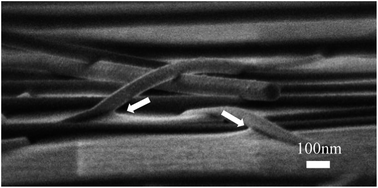High-intensity pulse light sintering of silver nanowire transparent films on polymer substrates: the effect of the thermal properties of substrates on the performance of silver films†
Abstract
Silver nanowire (AgNW) films with a random mesh structure have attracted considerable attention as high-performance flexible transparent electrodes that can replace the expensive and brittle ITO-sputtered films widely used in displays, touch screens, and solar cells. Methods such as heating, pressure treatment, and light treatment are usually used to obtain an optically transparent and electrically conductive film comparable to those of commercial ITO. However, the adhesion between the AgNW film and the substrate is so weak that other overcoatings or extra treatments are necessary. Here, a high-intensity pulsed light (HIPL) sintering technique was developed to rapidly and simply sinter the AgNW film and thus achieve strong adhesion and even high conductivity on these flexible polymer substrates which will be widely applied to the printing of electronic devices. The conductivity of the AgNW film closely depended on the thermal performance of substrates, and the adhesion was determined by the soft state of the substrate surface originating from the glass transition or melting of substrates with light intensity. The rapid sintering technique can be popularized to fabricate new devices on these polymer substrates by considering the thermal properties of the substrate to improve the performance of devices.


 Please wait while we load your content...
Please wait while we load your content...